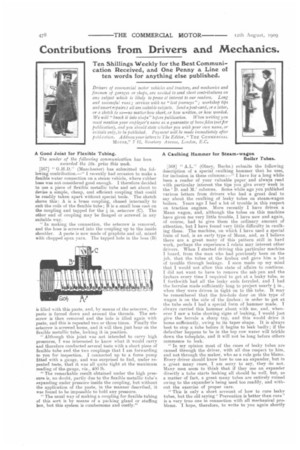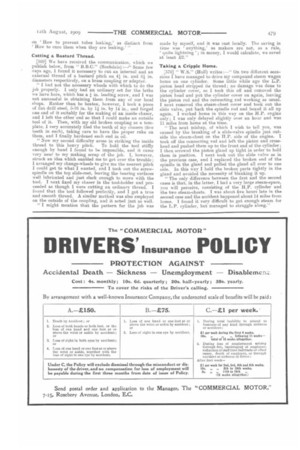Contributions from Drivers and Mechanics.
Page 16

Page 17

If you've noticed an error in this article please click here to report it so we can fix it.
Ten Shillings Weekly for the Best Communication Received, and One Penny a Line of ten words for anything else published.
Drivers of commercial motor vehicles and tractors, and mechanics and foremen of garages or shops, are tnvitcd to send short contributions on any subject which is likely to prove ot interest to our readers. Long and successful runs ; services with no "lost journeys" ; workshop tips and smart repairs : all are suitable subjects. Send a post-card, or a letter, or a sketch to us—no matter how short, or how written, or how worded. We will "knock it into shape" before publication. When writing you must mention your employer's name as a guarantee of bona fides (not for publication), and you should state whether you wish your own name, or initials only, to be published. Payment will be made immediately after publIcation. Address your letters to T lie Editor, " THE COMMERCIAL
Moron," 7 15, Rosebery Avenue, London, E.C.
A Good Joint for Flexible Tubing.
The sender of the following communication has been awarded the 10s. prize this week.
[567] " G.H.D." (Manchester) has submitted the following contribution.—" I recently had occasion to make a flexible water connection on a steam vehicle, where rubber hose was not considered good enough. I therefore decided to use a piece of flexible metallic tube and set about to devise a simple, cheap, and efficient coupling that could be readily taken apart without special tools. The sketch shows this: A is a brass coupling, chased internally to suit the coils of the flexible tube; B is a small boss cast on the coupling and tapped for the in. setscrew (C). The other end of coupling may be flanged or screwed in any suitable way.
" In making the connection, the setscrew is removed, and the hose is screwed into the coupling up to the inside shoulder. A paste is now made of graphite and oil, mixed with chopped spun yarn. The tapped hole in the boss (B) is filled with this paste, and, by means of the setscrew, the paste is forced down and around the threads. The setscrew is then removed and the hole is filled again with paste, and this is repeated two or three times. Finally the setscrew is screwed home, and it will then just bear on the flexible metallic tube, lacking it in position. " Although this joint was not intended to carry high pressures, I was interested to know what it would carry and therefore conducted several tests with a short piece of flexible tube and the two couplings that I am forwarding to you for inspection. I connected up to a force pump fitted with a gauge, and was surprised to find, under repeated testa, that it was all quite tight at the maximum reading of the gauge, viz., 400 lb. "The remarkable result obtained under the high pressure is, no doubt, partly due to the flexible metallic tube's expanding under pressure inside the coupling, but without the application of the paste, in the manner described, it was found to be impossible to hold any pressure.
"The usual way of making a coupling for flexible tubing of this sort is by means of a packing gland or stuffing box, but this system is cumbersome and costly." A Caulking Hammer for Steam-wagon Boiler Tubes.
[668] " A.L." (Olney, Bucks.) submits the following description of a special caulking hammer that he uses, for inclusion in these columns:—" I have for a long while been a reader of your valuable paper and always read with particular interest the tips you give every week in the D. and M.' columns. Some while ago you published various letters from drivers who had a great deal to say about the caulking of leaky tubes on steam-wagon boilers. Years ago I had a lot of trouble in this respect on traction engines. More recently I have driven a Mann wagon, and, although the tubes on this machine have given me very little trouble, I have now and again, of course, had to give them the ordinary amount of attention, but I have found very little difficulty in caulking these. The machine, on which I have used a special form of tool, is an early type of Mann, and, as I believe there are a great many of this pattern still in hard work, perhaps the experience I relate may interest other drivers. When I started driving this particular machine I heard, from the man who had previously been on the job, that the tubes at the firebox end gave him a lot of trouble through leakage. I soon made up my mind that I would not allow this state of affairs to continue. I did not want to have to remove the ash pan and the firehars every time I required to get at a leaky tube, so I forthwith had all the leaky ends ferruled, and I had the ferrules made sufficiently long to project nearly in., when they were driven in tight on to the tube. It may be remembered that the fire-hole door on this type of wagon is on the side of the firebox ; in order to get at the tube ends I had a special form of hammer made. I always carried this hammer about with me, and, whenever I saw a tube showing signs of leaking, I would just give the ferrule a sharp tap, and this would drive it home sufficiently, owing to its taper shape. It is always beat to stop a tube before it begins to leak badly; if the defaulter happens to be in the top row water will trickle down the tubepIate, and it will not be long before others commence to leak.
" In my opinion most of the cases of leaky tubes are caused through the driver, with all due respect to him, and not through the maker, who as a rule gets the blame. Every driver should know how to use an expander, but in a great many cases, I am sorry to say, they do not. Many men seem to think that if they use an expander directly a tube starts leaking all should be well, but, as a matter of fact, a great many tubes are entirely ruined owing to the expander's being used too readily, and without the exercise of proper care.
"This is only a short account of how to cure leaky tubes, but the old saying 'Prevention is better than cure' is a very true one in connection with all mechanical problems. I hope, therefore, to write to you again shortly on How to prevent tubes leaking,' as distinct from How to cure them when they are Leaking.' "
Cutting a Bastard Thread.
[569] We have received the communication, which we publish below, from " Bale." (Rochdale) :—" Some few clays ago, I. found it necessary to cut an internal and an external thread of a bastard pitch on 41in. and 61 in. diameters respectively, on a brass coupling or adapter.
"1 had not the necessary wheels with which to do the job properly. I only had an ordinary set for the lathe we have here, which has a k in. leading screw, and I was not successful in obtaining them from any of our local shops. Rather than be beaten, however, I took a piece of Eat drill steel, 5-16 in. by 1* in. by 14 in., and forged one end of it suitably for the making of an inside chaser, and I left the other end so that I could make an outside tool of it. Then, with my old broken coupling as a template, I very accurately filed the teeth of my chasers (five teeth in each), taking care to have the proper rake on them, and I finally hardened each end in oil.
" Now my second difficulty arose in striking the inside
thread to this heavy pitch. To hold the tool stiffly enough by hand I found to be impossible, and it came very near to my making scrap of the job. I, however, struck an idea which enabled me to get over the trouble; 1 arranged my change-wheels to give me the nearest pitch could get to what I wanted, and I took out the screwspindle on the top slide-rest, leaving the bearing surfaces well lubricated and just slack enough to move with the tool. I next fixed my chaser in the tool-holder and proceeded as though I were cutting an ordinary thread. I found that the tool followed perfectly, and I got a true and smooth thread. A similar method was also employed on the outside of the coupling, and it acted just as well. "I might mention that the pattern for the job was
made by myself, and it was cast locally. The saving in time was anything,' as makers are not, as a rule, quite lightning ' ; in money, I would calculate, we saved at least L2."
Taking a Cripple Home.
D.570] " W.S." (Hull) writes :—" On two different occasions I. have managed to drive my compound steam wagon home on one cylinder. Some little while ago the LP. piston head stripped its thread; no damage was done to the cylinder cover, so I took this off and removed the piston head and put the cylinder cover on again, leaving the piston rod and the connecting rod working as usual. I next removed the steam-chest cover and took out the slide valve, put back the spindle rod and boxed it all up again. I worked home in this way on the H.P. engine only; I was only delayed slightly over an hour and was 11 miles from home at the time.
" The next mishap, of which I wish to tell you, was caused by the breaking of a slide-valve spindle just outside the steam-chest on the H.P. side of the engine. I took oil the connecting rod and left the piston and crosshead and pushed them up to the front end of the cylinder ; then screwed the piston gland up tight in order to hold them in position. I next took out the slide valve as in the previous case, and I replaced the broken end of the spindle in the gland and pulled the gland all over to one side. In this way I held the broken parts tightly in the gland and avoided the necessity of blanking it up. "The only difference between the first and the second cases is that, in the latter, I had a very large steam-space, you will perceive, consisting of the H.P. cylinder and the two steam-chests. I was about five hours late in the second case and the accident happened about 14 miles from home. T found it very difficult to get enough steam for the L.P. cylinder, but managed to struggle along."


















